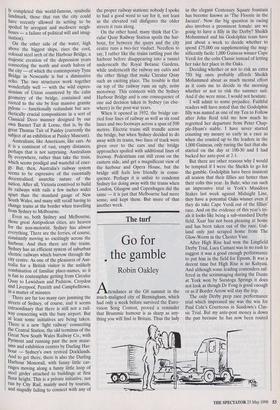Not motoring
Extraordinary experience
Gavin Stamp
Joseph Conrad knew the place well in the days of the wool-clippers, and he recalled how Circular Quay looked in 1880 — 'no walled prison-house of a dock that, but the integral part of one of the finest, most beautiful, vast, and safe bays the sun ever shone upon'. Since then, the scene has been made even more dramatic by great works of architecture and engineering. If Stockholm is made memorable by its city Hall, then Sydney has the Opera House. It was built on what must be the finest site in the world, at the very end of a promontory where once stood Fort Macquarie. It is astonishing — astonishing that Jorn Utzon's composition of shell-like, sail-like forms could ever have been built, despite all the practical and financial difficulties (and astonishing now that, having heroical- lY completed this world-famous, symbolic landmark, those that run the city could have recently allowed its setting to be spoiled by arrogant and mediocre neigh- bours — a failure of political will and imag- ination).
On the other side of the water, high above the biggest ships, rises the cool, colossal steel arch of the Harbour Bridge, a majestic creation of the depression years connecting the north and south halves of the city — of which the contemporary Tyne Bridge in Newcastle is but a diminutive echo. The two structures work together wonderfully well — with the wild expres- sionism of Utzon countered by the calm geometry of the bridge, contained and rooted to the site by four massive granite pylons — functionally redundant but aes- thetically crucial compositions in a sort of Classical Deco manner designed by our own Burnet Tait & Lorne, that is, by the great Thomas Tait of Paisley (currently the subject of an exhibition at Paisley Museum).
Australians, like Americans, like cars. As it is a continent of vast, empty distances, perhaps that is not surprising. Australians fly everywhere, rather than take the train, which seems prodigal and wasteful of ener- gy. But, then, Australia's railway system seems to be expressive of the essentially decentralised, anarchic nature of the nation. After all, Victoria contrived to build its railways with rails a few inches wider apart than the standard gauge of New South Wales, and many still recall having to change trains at the border when travelling from Sydney to Melbourne. Even so, both Sydney and Melbourne, those great Antipodean cities, are heaven for the non-motorist. Sydney has almost everything. There are the ferries, of course, constantly moving so excitingly across the harbour. And then there are the trains. Sydney has an efficient system of suburban electric railways which burrow through the city centre. As one of the pleasures of Aus- tralia for a British visitor is the unlikely combination of familiar place-names, so it is fun to contemplate getting from Circular Quay to Lewisham and Padstow, Croydon and Liverpool, Penrith and Campbelltown, in a matter of minutes.
There are far too many cars jamming the streets of Sydney, of course, and it seems extraordinary that there is still not a rail- way connecting with the busy airport. But at least some initiatives are being taken. There is a new 'light railway' connecting the Central Station, the old terminus of the Great New South Wales Railway Co., with Pyrmont and running past the new muse- urns and exhibition centres by Darling Har- bour — Sydney's own revived Docklands. And to get there, there is also the Darling Harbour Monorail, with funny little car- riages moving along a funny little loop of steel girder attached to buildings at first floor height. This is a private initiative, not run by City Rail, mainly used by tourists, and stupidly failing to connect with any of the proper railway stations; nobody I spoke to had a good word to say for it, not least as the elevated rail disfigures the older streets it runs along.
On the other hand, many think that Cir- cular Quay Railway Station spoils the har- bour, for between the quays and the city centre runs a two-tier viaduct. Needless to say, I rather like the trains rattling past the harbour before disappearing into a tunnel underneath the Royal Botanic Gardens, while underneath the railway are cafés and the other things that make Circular Quay such an exciting place. The trouble is that on top of the railway runs an ugly, noisy motorway. This connects with the Sydney Harbour Bridge and is one consequence of one sad decision taken in Sydney (as else- where) in the post-war years.
When it opened in 1932, the bridge car- ried four lines of railway as well as six road lanes and two footways across a span of 500 metres. Electric trains still trundle across the bridge, but when Sydney decided to do away with its trams, two lines of track were given over to the cars and the bridge approaches spoiled with additional lines of freeway. Pedestrians can still cross on the eastern side, and get a magnificent view of the harbour and Opera House, but the bridge still feels less friendly in conse- quence. Perhaps it is unfair to condemn Sydney for doing away with the trams when London, Glasgow and Copenhagen did the same — it is just that Melbourne had more sense, and kept them. But more of that another week.



































































 Previous page
Previous page